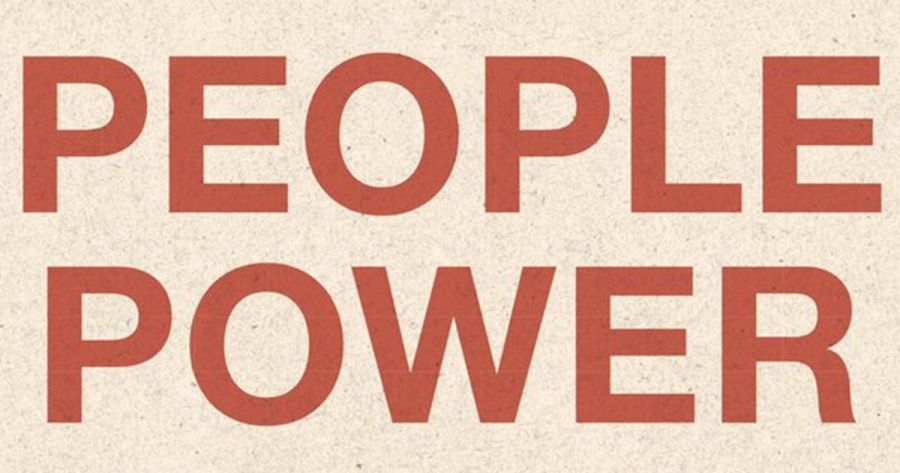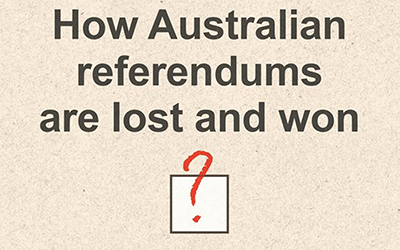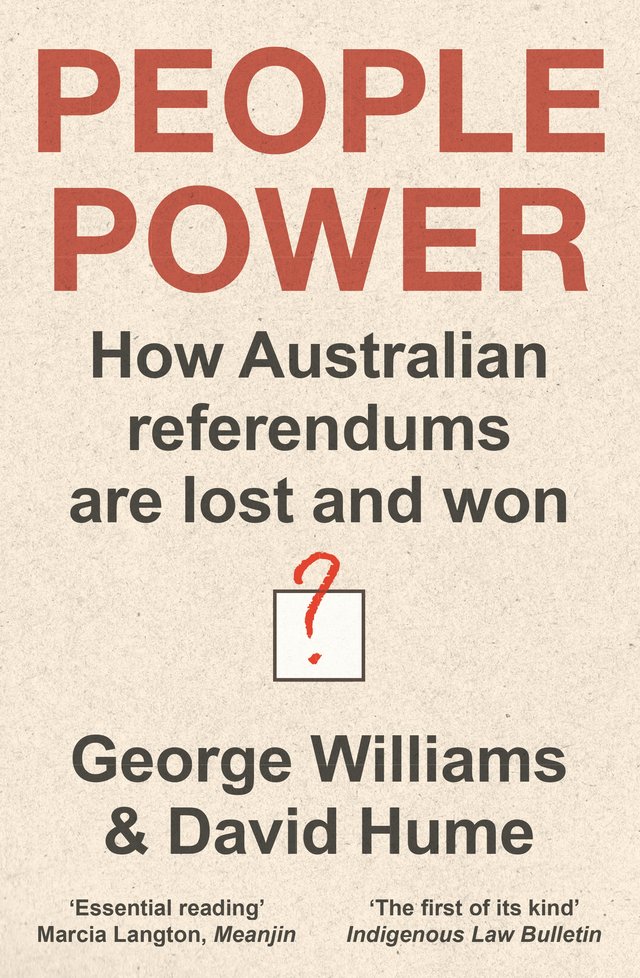
- Free Article: No
- Contents Category: Law
- Review Article: Yes
- Article Title: Political booby traps
- Article Subtitle: The inglorious history of referendums
- Online Only: No
- Custom Highlight Text:
People have peculiar but passionate views about referendums. A large number swear that in 1974 and 1988 the people voted against referendums on the existence of local government. To them, local government is ‘unconstitutional’, so they don’t have to pay their council rates. Members of the same cohort also proclaim that they have a constitutional right to trial by jury for state criminal offences and a right to compensation on just terms if a state compulsorily acquires their land.
- Featured Image (400px * 250px):

- Alt Tag (Featured Image): Anne Twomey reviews ‘People Power: How Australian referendums are lost and won’ by George Williams and David Hume
- Book 1 Title: People Power
- Book 1 Subtitle: How Australian referendums are lost and won
- Book 1 Biblio: Second Edition, UNSW Press, $49.99 pb, 346 pp
- Book 1 Cover Small (400 x 600):

- Book 1 Cover (800 x 1200):

While the Commonwealth Constitution provides a limited guarantee of trial by jury in relation to Commonwealth offences, and just terms compensation if the Commonwealth compulsorily acquires your property, this does not apply in relation to state offences, which cover most criminal law, or state compulsory acquisitions. At the 1988 referendum, the people voted against extending these constitutional guarantees of trial by jury and just terms compensation to the state level.
Every time I told my students that the Australian people actually voted in a referendum against the constitutional protection of just terms compensation if their property is compulsorily acquired by a state, I would watch their mouths drop open in shock. The official No case for that referendum came up with this marvellously misleading argument, which relies on voter ignorance and fear:
It is unnecessary because the Australian Constitution already recognises trial by jury, religious freedom and the right to compensation if a government compulsorily acquires your private property. This proposal does not strengthen, and may indeed weaken, the force of those provisions. And does anybody seriously suggest that these fundamental freedoms are under threat in Australia?
There is an additional reason why people voted against this referendum question. It is because it also extended ‘freedom of religion’ to the state level, and a number of religious groups opposed it, fearing that it would impose more limits than protections on religious bodies. The price of bundling three different rights into one question is failure, if voters have doubts about one part. Indeed, this referendum question received the lowest support of all national referendums held in Australia, with just 30.79% support.
There is a genuine need for a book that can educate people about referendums, their history and effect. Those who propose referendums also need help to avoid the many pitfalls on the way to elusive success. People Power: How Australian referendums are lost and won, by George Williams and David Hume, is intended to fill that need. It is the second edition of a work previously published in 2010, which has been updated to accommodate the lessons learned from the abandoned local government referendum of 2013, the same-sex marriage postal plebiscite of 2017, and the Indigenous Voice referendum of 2023.
Williams is well known as a former professor of constitutional law at UNSW, and now the vice-chancellor of Western Sydney University. Hume is a barrister who has appeared in many constitutional cases. While both come at the subject from a constitutional law background, the book is written engagingly in plain English and is devoid of esoteric academic theory and legal terminology. It is an easy read for the non-expert – as it should be.
The book explains how referendums work in Australia, from the development of reform ideas to the execution of the referendum process. It discusses referendum campaigns and Australia’s poor record of referendum success. Eight referendums, including the 1951 Communist Party referendum, the 1967 Aboriginal referendum, and the 1999 republic referendum, are discussed in greater detail. These historical accounts are enhanced by striking illustrations of campaign advertisements and cartoons, which capture the atmosphere of those campaigns.
Three new chapters have been added to this second edition. The first is on national plebiscites, being those popular votes that do not change the Constitution but that indicate the views of the people on contentious social matters. This provides an opportunity to explore the political tumult of the two conscription plebiscites in 1916 and 1917 and the rather peculiar history of ‘Advance Australia Fair’ becoming Australia’s national anthem. Much of the focus, however, is on the same-sex marriage postal plebiscite and the lessons that can be learned from the use of plebiscites.
A new chapter on state and territory referendums and plebiscites fills a hole in previous studies of referendums, which tend to focus on the Commonwealth. The political dynamics are different in state referendums, which is well explained by the authors. They also point out that sometimes a vote of the people is required by state laws on non-constitutional matters. One particularly pointed example is section 21 of Queensland’s Nuclear Facilities Prohibition Act 2007. It says that if the state minister is satisfied that the Commonwealth is likely to support or allow the construction of a prohibited nuclear facility in Queensland, the minister is obliged to hold a plebiscite to obtain the views of the people. While the result of such a plebiscite would not bind anyone, the authors observe that ‘a No vote (or even the mere possibility of a referendum on the topic) may deter federal action’. It is a cunningly placed political booby trap, implanted in a state law to deter future Commonwealth action.
One feature of state plebiscites is that they can give people a range of options, rather than the binary Yes/No choice of federal referendums. But asking the people for their view risks getting an unexpected answer. For example, after drunken soldiers rioted in 1916, there was pressure on the New South Wales government to restrict pub hours. Politicians disagreed about whether pub closing time should be 9 pm or 10 pm. A vote was put to the people, giving a range of choices and, to the horror of those politicians who enjoyed their evening libations, the people voted for pubs to close at 6 pm.
The third new chapter, unsurprisingly, is an analysis of the Indigenous Voice referendum. It lays out a summary of the background of the proposal, its wording, and the campaign. While the book, on the whole, succeeds in its aim of being factual, objective, and non-partisan in its analysis, this aim slips a little in the description of both the same-sex postal plebiscite and the Indigenous Voice referendum. Perhaps it is simply too soon for cold, hard objectivity. The embers of the referendum fire still burn, as seen in a number of other books recently published on the Voice referendum.
Disputes about referendums will continue to rage. Even the use of ‘referendums’ as opposed to ‘referenda’ can lead to academic duels at ten paces. For my part, I used ‘referenda’ for decades, until finally looking into this arcane dispute and accepting the error of my ways. Those who insist that local government is ‘unconstitutional’ because of past referendums will probably never be convinced of the error of their ways, but for the rest of us, who are open to learning and thinking, this book is engaging, thought-provoking, and educative.


Comments powered by CComment